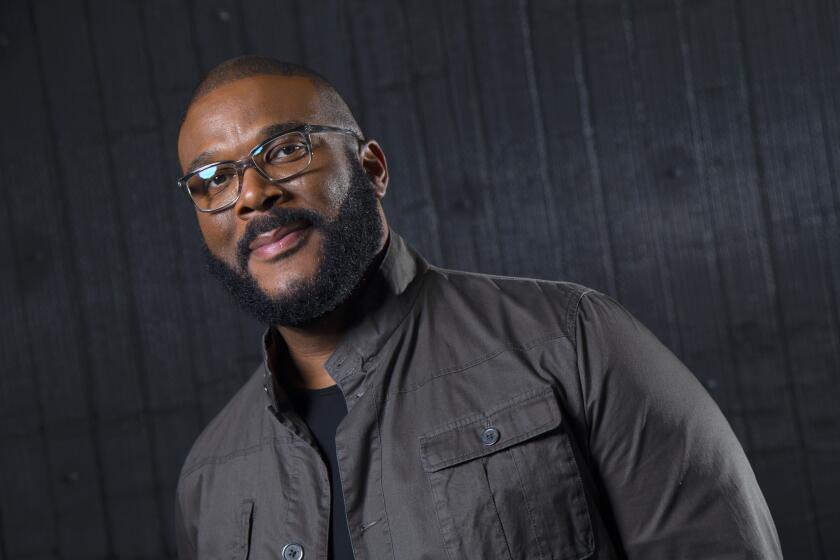ART REVIEWS : Some Funny Business From Daniel Wiener
- Share via
A loopy parade of pre-Oedipal playthings surrounds the visitor to Daniel Wiener’s jam-packed exhibition of unnamable sculptural objects at Dorothy Goldeen Gallery. Exuberantly colored, multi-textured and polymorphously perverse, his nonsensical configurations seem to be the offspring of abstract characters from mutant cartoons and leftover bits of unattached libidinal energy.
Each of Wiener’s eight, goofily animated arrangements of precisely twisted wire, suggestively poured plaster, lovingly sewn fabric and obsessively wadded Sculpey (the adult version of Play-Doh), gives the impression that it has, if not a personality of its own, at least a particular style--a consistent, if inarticulate mode of being in the world.
Two pieces dangle from the ceiling like psychedelic spiders tangled up in their webs; two teeter on the edges of spindly legged pedestals; two sit on swollen muslin cushions like cuddly sultan slugs; and two others sprout from gloppy puddles of spilled plaster, growing like beanstalks to the ceiling of the gallery.
You can easily imagine that Wiener’s hodge-podges of stuff are the result of a chance encounter between 19th-Century psychoanalyst Wilhelm Reich and the lovable puppets from “Sesame Street.” It is as if Reich, who is now regarded as a benign, crackpot therapist, smuggled one of his “orgone accumulators” onto the set of the children’s TV program and let the inquisitive characters experiment with his demented invention.
With an open invitation to poke and prod their endlessly fingerable protrusions, orifices, lumps and tentacles, Wiener’s guiltless constructions appear to be driven by a compulsion to communicate. Unambiguously oral--but never fixated at this stage--they seem to silently stutter and scream. Some spasmodically gesticulate and others blankly stare, as if the messages they must convey are both impossible to express and simple, both foreign to language and common to us all.
Wiener’s small to larger-than-life-size toys mischievously scamper across categories, boundaries and definitions. They embody a surplus of energy that is both physical and psychic. Their infectious vitality flows electrically between these two worlds, charging aspects of each with effects that are as specific as they are unsayable.
These funny works arouse curiosity and stimulate interest because they incessantly migrate from one strange association to another unforeseen connection, never resting for very long on anything with which our conscious minds are too familiar.
Wiener’s delightful art is a joyous celebration of the powers of nonverbal communication. Like a hallucinatory game of charades, his installation demonstrates that the pleasures of naming are not exhausted by that which is captured in words. His playful objects insist that what’s best about language exceeds and escapes its normal formations, spilling over into the space at the borders of sense, where bodies and nomination rub up against one another, shift positions, and generate significance.
* Dorothy Goldeen Gallery, 1547 9th St., Santa Monica, (310) 476-7145, through Dec . 31 . Closed Sundays and Mondays.
Masters in Miniature: Marc Pally’s nearly colorless paintings at Rosamund Felsen Gallery pack a surprising visual punch. They also sneak up on you with a sense of wit that slowly--and doubly--repays your attention.
At first, the fluid doodles and obsessively drawn lines in Pally’s abstractions seem to be clever combinations of blown-up views of microscopic life-forms and melted-down patterns from ‘70s Op Art. As your eyes adjust to the richly textured, interconnected webs that make up the illusion-riddled surfaces of his paintings, however, their supple humor clicks into focus.
Pally’s newest body of work creates the impression that he has scrutinized the tiniest micro-organisms and studied the most minuscule cellular structures only to discover that these fundamental building blocks of life have a highly developed sense of taste and an extremely eccentric conception of fashion.
In the fantastic, black-and-white world his paintings convincingly conjure, squiggly, amoeba-like beings and serpentine blobs of protoplasmic matter not only cavort gracefully in imaginary dances. They also appear to be wearing wild paisley patterns, outlandish plaid outfits and irregular checker-board designs.
It is as if Pally, in his diligent attempt to visualize the primordial stuff of life, has discovered that decoration is as essential to human existence as is the proper combination of elements of cells. His various shaped acrylics on canvas thus eloquently argue that nature and culture are two sides of the same coin.
In his best paintings, such as the bandage-shaped “Topsy Turvy Lake” and the circular “Tharp’s Rock,” this metaphorical coin appears to be a translucent disk. As if it were a living visual fossil, its parallel surfaces preserve a biomorphic melange of animated activity. You cannot distinguish between which parts of the image sit on the side of culture and which ones occupy the opposite face of nature.
These two paintings stand out in the 46-year-old, L.A.-based artist’s impressive exhibition because of their crispness, clarity and sense of lyrical movement. The first has the mesmerizing feel of a slow-motion, underwater exploration. The second seems to fly through space, suggesting that the picture plane is the windshield of some sci-fi vehicle onto which a handful of beautiful bug-like organisms have splattered.
Pally’s show demonstrates that painting is particularly well suited to address the multiple interfaces between nature and culture. His art takes its position between abstraction and representation in order to lure its viewers into the ambiguous territory where nothing is purely one or the other.
Rosamund Felsen Gallery, 8525 Santa Monica Blvd., (310) 652-9172, through Dec . 19 . Closed Sunday and Mondays. Puppy Love: William Wegman’s well-known pet photographs at Linda Cathcart Gallery have all the attributes of sentimental schlock. In terms of subject matter, not much separates them from those ubiquitous rec-room pictures of hounds playing poker or shooting pool. In terms of formal composition, little distinguishes them from the snapshots proud owners never tire of taking of their adorable pets.
Nevertheless, Wegman’s photographs of several Weimaraners and a litter of puppies fascinate and intrigue, as well as entertain and amuse. Long after you stop wondering, “How did he get those dogs to do that?” you begin to wonder about questions typically reserved for the art of portraiture. The relationship between artist and model, or photographer and sitter, becomes, in his art, a question of the relationship between animals and human beings.
Part of Wegman’s genius is his capacity to create the illusion that his dogs are more sensitive and intelligent than the people who look at them. In one picture, a 4-year-old named Battina sprawls languorously on the running board of a battered red truck, casting her eyes toward the viewer with an absolutely mastered “come-hither” glance. In others, the infinitely patient dogs pose like tourists or perform like acrobats, always with expressions of dignity and wisdom. Their unflappable demeanors make the photographer seem silly in comparison.
Wegman enters these pictures by making their serious analysis seem pretentious and academic. Each image seems to insist that it is, after all, nothing more than a photograph of a dog. With this fraudulent yet undeniable sense of humility, Wegman puts an ironic spin on his art, playing another light-handed trick that intensifies the interest of this series.
Linda Cathcart Gallery, 924 Colorado Ave., Santa Monica, (310) 451-1121, through Dec . 24 . Closed Sundays and Mondays.
Fluff and Force: Richard Hawkins’ exhibition of limpid fabric cut-outs, altered books and collaged images sharply divides between self-indulgent fluff and hard-edged substance. In contrast to the materials out of which they have been made, his drooping streamers carry more force than his fragments of gay pornography glued over photographic reproductions and famous artists’ exhibition catalogues.
Titled “. . . and November, in this year of no hope, without gladness . . .,” his installation at Roy Boyd Gallery strikes a coy, knowing pose between the activist stance that characterized much art of the ‘80s and an exquisite sense of self-involved withdrawal. The problem with these alternatives, Hawkins’ work softly asserts, is that each rings hollow in the present, having collapsed into its opposite.
As if his collages had been made by a cocky exhibitionist, they parade male beauty and gay desire across their slick bits of paper. What was, in the past, a proud articulation of self-identity now looks like the outdated fantasy of a narcissistic egomaniac.
In contrast, Hawkins’ velvet, felt, taffeta and silk wall pieces give form to sad poignance. Having shed the images that were once paper-clipped to them, the works in this series resemble shredded ceremonial robes. Rendered useless, these violated garments seem to be saved only for the memories they evoke, for lost dreams and shattered ideals.
Caught between being a rerun of fin-de-siecle decadence and boring political correctness, Hawkins’ art embodies a powerful sense of confused lassitude. Resigned, but hardly nostalgic, his wilted, oversized wallflowers restlessly bide their time until things might be different.
Roy Boyd Gallery, 1547 10th St., Santa Monica, (310) 394-1210, through Dec . 12 . Closed Sundays and Mondays.
More to Read
The biggest entertainment stories
Get our big stories about Hollywood, film, television, music, arts, culture and more right in your inbox as soon as they publish.
You may occasionally receive promotional content from the Los Angeles Times.










